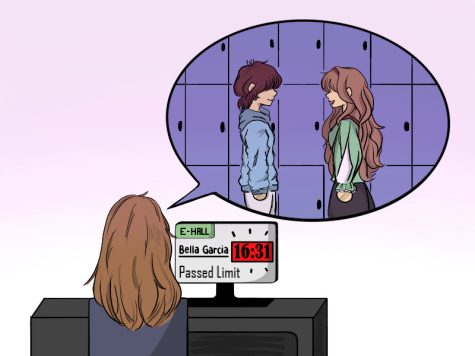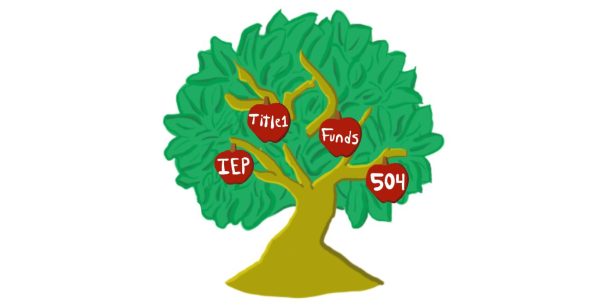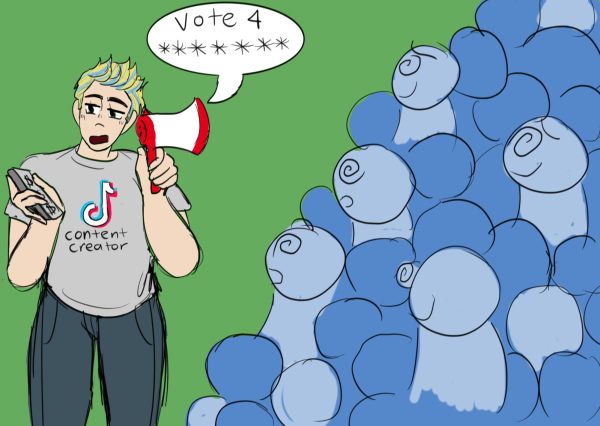Yes/No: Are E-hall passes effective in the classroom?
Yes.
By: Grace Na

Students are waiting patiently for their teachers to excuse them from the classroom, trying to reach their destined location. As the teacher approves the request, the stopwatch starts running. The teacher stops the digital hall pass from timing once they confirm that the students are back in class.
For the 2022-2023 school year, Bonita Vista High (BVH) implemented the usage of E-Hall passes (EHP). The decision to switch to a digital hall pass was made due to an increase in restroom usage during class. Some students have misused the traditional pass to meet up with friends or skip class, vandalize school property or to vape in the bathrooms.
According to the official E-Hall Pass website, the program was designed to manage “student passes and tracking student movement during school hours throughout the day.” The digital hall pass allows teachers to see the destination a student must go to and approve or disapprove it before they are allowed to arrive there. After the student returns back from their designated location, teachers are able to see how long the trip took to complete. Furthermore, the E-hall pass has a feature allowing teachers to limit the number of passes a student can use throughout a specific date range.
Although some may argue that EHP invades students’ privacy, it allows teachers to manage and keep students accountable. Furthermore, it allows schools to keep track of student activities on campus. According to “Students Are Damaging School Bathrooms For Attention On TikTok”, written by James Doubek, an associate editor and reporter for National Public Radio, vandalizing school bathrooms have been trending—whether it be stealing school property such as soap or damaging school property such as the sink or clogging toilets.
As vandalism of school property is an ongoing issue on BVH’s campus, implementing EHP helps teachers track where students are, how long they have been out of the classroom for and at what time. If there were to be reports of vandalism on campus, after investigating the closest time the event occurred, the school can easily check who had been at that same location at a similar time, keeping students who participate in vandalism accountable.
Furthermore, as EHP has a feature where it tracks how long a student has been out, it limits the amount of time students can be out of the classroom. This leads to students not being able to meet up with friends or wander around the school. The usage of EHP helps students reduce the number of times they leave their class. In the long run, it benefits students as they do not miss out on class time.
According to Clever, EHP gives schools access to “place pass limits on individual students or by grade level or assign limits by location based on capacity.” At times when a student is misbehaving, school administrators or teachers have the ability to monitor the student by setting limits.
Overall, EHP keeps students accountable, manages students regarding staying in class for a longer period of time for lessons and allows them to stay in class for a longer period of time. With the beneficial outcomes of EHP, it is clear that BVH’s decision of switching from the traditional hall pass to the online hall pass will be extremely beneficial for both students and teachers at BVH.
No.
By: Isaiah Nafarrete
At the start of the 2022-2023 school year, Bonita Vista High (BVH) implemented the use of the E-Hall Pass—a more modern take on the traditional hall passes. Rather than students taking a pass with them to leave the room, students are now required to send a request to their teachers on the website in order to receive a pass. The pass gives students a 10 minute timer which the teacher will end once the student returns to the class. Overall, the implementation of E-Hall Pass has caused a decline in efficiency and traditional hall passes worked perfectly fine.

The main reason E-Hall Pass was implemented is the problem with students spending too much time outside of class and loitering inside bathrooms or around campus. The website allows a teacher to keep track of how long a student is out. If they do not come back within 10 minutes, the AP’s on campus will be notified. Since time is tracked by the website—something that physical hall passes were incapable of—students are much more inclined to return to class on time.
However, many students question the effectiveness of such a pass. After all, it seems redundant to implement an entirely new system that should provide a more “efficient” method of keeping track of students. The majority of the BVH student population was already familiar with the physical hall pass.
For starters, E-Hall Passes requires more work from both students and teachers to function. A student must send their teacher a request from their mobile device, to which the teacher must accept it on their own computer. This requires students to select which class they’re leaving and what location they’re going to.
Many problems arise here, one being that the E-Hall Pass app itself is unstable. The app is very inconsistent. When paired with WiFi issues that many students experience, it creates an irritating user experience. The app often takes a while to load for both the student and teacher, especially in different areas on campus that have varying levels of service available. This takes an unnecessary chunk of time out of class that could’ve been used for other activities.
Students may also interrupt instruction for greater periods of time since teachers must approve the request on their computers or mobile devices. This could take upwards of two minutes per student or more. Compared to normal hall passes, where a teacher simply has to say “Yes” or “No,” a student takes the pass with them out of the classroom without having to waste or interrupt class time.
The app also requires fees to use, as it is stated on the official Eduspire website that it costs around $3.25 per student to use the product. As BVH has a population around 2,000 students, this equates to nearly $7,000 in fees to use the app. These absurd costs could be completely avoided if E-Hall Pass wasn’t being paid for, as $7,000 in unnecessary fees is a huge loss in money for the BVH and the Sweetwater Union High School District. This money could be put to use on other parts of the campus, such as for restroom renovations.
Furthermore, privacy concerns are an issue for both students and parents. The data that the E-Hall pass tracks is unknown to the public. Heather Kelly, technology reporter from The Washington Post writes, “districts are not required to inform parents of every type of software students use. And the apps, as well as the schools deploying them, have different rules for how they use, share and store data.”
The app can be used for anything related to a student leaving the classroom, so not knowing what data is being collected is a cause for concern.
The implementation of E-Hall Pass will continue to face opposition from students. The extra work required from both students and teachers, the fees to use the app as well as privacy concerns are all parts of why E-Hall Pass is inefficient. It is simply impractical and unnecessary to impose a system that replaces one widely known and accepted by students when considering the drawbacks that it creates.

As a senior and Editor-in-Chief of BVH’s the Crusader, I hope to guide the publication to continue publishing articles that have an impact on our community....

I am currently a senior at Bonita Vista High and this is my second year on staff as a Features Editor. I was previously the Videographer and chose to...

Hello, I am a senior at BVH and this is my fourth year as part of the Crusader staff. I am currently the Managing editor and was previously a News Editor,...

I am a senior at Bonita Vista High and this is my second year on staff. Currently, I am the Managing Editor for the Crusader and was previously an Opinion...





Eric Helle • Oct 5, 2022 at 12:57 pm
While I appreciated Ms. Na’s positive reception of a new program being implemented in order to track students outside of class, I found myself swayed by Mr. Nafarrete’s observed pitfalls. As a teacher, I missed the one training for this app due to a medical leave and no one has approached me to train me on this process and ensure that I can access the app and can put it to confident use. I wonder how many teacher’s are in a similar situation. While I want a safe campus free from hate speech, graffiti and other acts of malevolent mayhem, I’m not sure Ms. Na’s stated results are actually true. We just recently had bathroom vandalism while the campus made use of the app and the vandals still go uncaught. Perhaps the school administration can share data at the end of the semester that tips my beliefs convincingly to one side or the other. For now, I will remain open-minded and hopeful that we are not spending money that could be put to better use. When I was coming up through the teaching training, I was lead to believe that this is a class management issue rather than a prerequisite for datamining and surveillance. 🙂